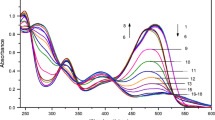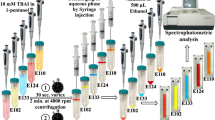Abstract
Concerning the importance of the identification and characterization of food dyes in food science, this work presents a screening method using voltammetry of immobilized microparticles for identification in solid state of sunset yellow, tartrazine yellow, brilliant blue, indigotine, and erythrosine in food matrices. Different aqueous supporting electrolyte were investigated for screening purpose and NaCl 0.1 mol L−1 showed to be suitable for evaluating dyes in solid state. By using square wave voltammetry as detection mode was possible to establish qualitative diagnostic criteria for identification of dyes in commercials powder of food dyes samples using both anodic and cathodic scan. Moreover, based on the solid-state electrochemistry profile and due to the lack of information about the electrochemical behavior of these compounds in solid state, some oxi/reduction pathways could be elucidated, and special attention was given to the case of sunset yellow dye.















Similar content being viewed by others
References
Kobylewski S, Jacobson MF (2012) Toxicology of food dyes. Int J Occup Environ Health 18(3):220–246. https://doi.org/10.1179/1077352512Z.00000000034
Stoforos NG (2015) Handbook of food processing. CRC Press, Boca Raton
Zhao X, Hu W, Wang Y, Zhu L, Yang L, Sha Z, Zhang J (2018) Decoration of graphene with 2-aminoethanethiol functionalized gold nanoparticles for molecular imprinted sensing of erythrosine. Carbon 127:618–626. https://doi.org/10.1016/j.carbon.2017.11.041
Council Directive 94/36/EC of 30 June 1994 on colours for use in foodstuffs Official Journal (1994) European Parliament, Brussels. https://eur-lex.europa.eu/legal-content/EN/ALL/?uri=celex:31994L0036.
Resolução n° 388 (1999) Agência Nacional de Vigilância Sanitária (ANVISA), Brasil http://portal.anvisa.gov.br/documents/33916/391619/RESOLUCAO_388_1999.pdf/ac1c03bc-17b8-46a1-b8e5-1003d3a930d8.
Code of Federal Regulations: Color Additives Listed for Use in Food (2015) Food and Drug Administration, Maryland. https://www.fda.gov/industry/color-additive-inventories/summary-color-additives-use-united-states-foods-drugs-cosmetics-and-medical-devices.
Amchova P, Kotolova H, Ruda-Kucerova J (2015) Health safety issues of synthetic food colorants. Regul Toxicol Pharmacol 73(3):914–922. https://doi.org/10.1016/j.yrtph.2015.09.026
Faraji M (2019) Determination of some red dyes in food samples using a hydrophobic deep eutectic solvent-based vortex assisted dispersive liquid-liquid microextraction coupled with high performance liquid chromatography. J Chromatogr A 1591:15–23. https://doi.org/10.1016/j.chroma.2019.01.022
Floriano L, Ribeiro LC, Saibt N, Bandeira NMG, Prestes OD, Zanella R (2018) Determination of six synthetic dyes in sports drinks by dispersive solid-phase extraction and HPLC-UV-Vis. J Braz Chem Soc. https://doi.org/10.21577/0103-5053.20170173
Krug FJ (2010) Métodos de preparo de amostras: fundamentos sobre o preparo de amostras orgânicas e inorgânicas para análise elementar. EditSBQ, São Paulo
Doménech-Carbó A, Doménech-Carbó MT, Calisti M, Maiolo V (2010) Sequential identification of organic dyes using the voltammetry of microparticles approach. Talanta. 81(1-2):404–411. https://doi.org/10.1016/j.talanta.2009.12.016
Martínez-Lázaro I, Doménech-Carbó A, Doménech-Carbó MT, Pastor-Valls MT, Amigó-Borrás V (2010) Electrochemical criteria for evaluating conservative treatments applied to contemporary metallic sculpture. A case study. J Solid State Electrochem 14(3):437–447. https://doi.org/10.1007/s10008-009-0908-0
Scholz F, Nitschke L, Henrion G, Damaschun F (1989) Abrasive stripping voltammetry - the electrochemical spectroscopy for solid state: application for mineral analysis. Fresenius’ Zeitschrift Für Anal Chemie 335(2):189–194. https://doi.org/10.1007/BF00522248
Scholz F, Schröder U, Gulaboski R (2015) Electrochemistry of immobilized particles and droplets. Springer, Berlin
Komorsky-Lovrić Š, Scholz F (1998) Stripping chronopotentiometry of immobilized microparticles. J Electroanal Chem 445(1-2):81–87. https://doi.org/10.1016/S0022-0728(97)00569-X
Maciel JV, Fava EL, Silva TA, Dias D, Fatibello-Filho O (2017) A combination of voltammetry of immobilized microparticles and carbon black-based crosslinked chitosan films deposited on glassy carbon electrode for the quantification of hydroquinone in dermatologic cream samples. J Solid State Electrochem 21(10):2859–2868. https://doi.org/10.1007/s10008-017-3614-3
Maciel JV, Silva TA, Dias D, Fatibello-Filho O (2018) Electroanalytical determination of eugenol in clove oil by voltammetry of immobilized microdroplets. J Solid State Electrochem 22(7):2277–2285. https://doi.org/10.1007/s10008-018-3933-z
Martini M, Machado De Carvalho L, Blasco-Blasco A, Doménech-Carbó A (2015) Screening and authentication of herbal formulations based on microextraction-assisted voltammetry of microparticles. Anal Methods 7(14):5740–5747. https://doi.org/10.1039/c5ay01145k
Doménech-Carbó A, De Carvalho LM, Martini M, Cebrián-Torrejón G (2014) Voltammetric/amperometric screening of compounds of pharmacological interest. Rev Anal Chem 33(3). https://doi.org/10.1515/revac-2013-0027
Doménech-Carbó A, da Silveira GD, Medina-Alcaide MÁ, Carmona AM, López-Serrano D, Pasíes-Oviedo T, Algarra-Pardo VM, de Carvalho LM, Montoya N (2018) Polythiophenes as markers of asphalt and archaeological tar pitch aging. Characterization using solid-state electrochemistry. Electrochem Commun 87:18–21. https://doi.org/10.1016/j.elecom.2017.12.020
Doménech-Carbó A, Doménech-Carbó MT, Pascual MLVA (2006) Dehydroindigo: a new piece into the Maya Blue puzzle from the voltammetry of microparticles approach. J Phys Chem B 110(12):6027–6039. https://doi.org/10.1021/jp057301l
Doménech-Carbó A, Martini M, De Carvalho LMH, Doménech-Carbó MT (2012) Square wave voltammetric determination of the redox state of a reversibly oxidized/reduced depolarizer in solution and in solid state. J Electroanal Chem 684:13–19. https://doi.org/10.1016/j.jelechem.2012.08.016
Doménech-Carbó A, Doménech-Carbó MT, Pascual MLVA (2007) Chemometric study of Maya Blue from the voltammetry of microparticles approach. Anal Chem 79(7):2812–2821. https://doi.org/10.1021/ac0623686
Grygar T, Kučková Š, Hradil D, Hradilová J (2003) Electrochemical analysis of natural solid organic dyes and pigments. J Solid State Electrochem 7(10):706–713. https://doi.org/10.1007/s10008-003-0380-1
Doménech-Carbó A, Doménech-Carbó MT, Saurí-Peris MC, Gimeno-Adelantado JV, Bosch-Reig F (2003) Electrochemical identification of anthraquinone-based dyes in solid microsamples by square wave voltammetry using graphite/polyester composite electrodes. Anal Bioanal Chem 375(8):1169–1175. https://doi.org/10.1007/s00216-002-1742-8
Lovrić M, Scholz F (1997) A model for the propagation of a redox reaction through microcrystals. J Solid State Electrochem 1(1):108–113. https://doi.org/10.1007/s100080050030
Doménech-Carbó A, Dias D, Doménech-Carbó MT (2020) Cation and anion electrochemically assisted solid-state transformations of malachite green. Phys Chem Chem Phys 22(3):1502–1510. https://doi.org/10.1039/c9cp05835d
Doménech-Carbó A (2012) Solvent-independent electrode potentials of solids undergoing insertion electrochemical reactions: Part I. theory. J Phys Chem C. https://doi.org/10.1021/jp308966w
Doménech-Carbó A, Labuda J, Scholz F (2013) Electroanalytical chemistry for the analysis of solids: characterization and classification (IUPAC technical report). Pure Appl Chem 85(3):609–631. https://doi.org/10.1351/PAC-REP-11-11-13
Scholz F, Doménech-Carbó A (2019) The thermodynamics of insertion electrochemical electrodes - a team play of electrons and ions across two separate interfaces. Angew Chem Int Ed 58(11):3279–3284. https://doi.org/10.1002/anie.201809631
Doménech-Carbó A, Doménech-Carbó MT (2006) Chronoamperometric study of proton transfer/electron transfer in solid state electrochemistry of organic dyes. J Solid State Electrochem 10(12):949–958. https://doi.org/10.1007/s10008-005-0018-6
Doménech A, Doménech-Carbó MT, de Agredos Pascual MLV (2007) Electrochemical monitoring of indigo preparation using Maya’s ancient procedures. J Solid State Electrochem 11(9):1335–1346. https://doi.org/10.1007/s10008-007-0296-2
Doménech A, Doménech-Carbó MT, del Río MS, de Agredos Pascual MLV (2009) Comparative study of different indigo-clay Maya Blue-like systems using the voltammetry of microparticles approach. J Solid State Electrochem 13(6):869–878. https://doi.org/10.1007/s10008-008-0616-1
Yamjala K, Nainar MS, Ramisetti NR (2016) Methods for the analysis of azo dyes employed in food industry - a review. Food Chem 192:813–824. https://doi.org/10.1016/j.foodchem.2015.07.085
Vladislavić N, Buzuk M, Rončević IS, Brinić S (2018) Electroanalytical methods for determination of sunset yellow - a review. Int J Electrochem Sci. https://doi.org/10.20964/2018.07.39
Ahmad I, Murtaza S, Ahmed S (2015) Electrochemical and photovoltaic study of sunset yellow and tartrazine dyes. Monatsh Chem 146(10):1631–1640. https://doi.org/10.1007/s00706-015-1425-8
Yu J, Jia J, Ma Z (2004) Comparison of electrochemical behavior of hydroxyl-substituted and nonhydroxyl-substituted azo dyes at a glassy carbon electrode. J Chin Chem Soc 51(6):1319–1324. https://doi.org/10.1002/jccs.200400191
Carey FA (2008) Organic chemistry. AMGH, New York
da Silveira GD, de Carvalho LM, Montoya N, Domenech-Carbó A (2017) Solid state electrochemical behavior of organosulfur compounds. J Electroanal Chem 806:180–190. https://doi.org/10.1016/j.jelechem.2017.10.055
Socrates G (2001) Infrared and Raman characteristic group frequencies. Wiley, Middlesex
da Silveira GD, Bressan LP, Schmidt MEP, Dal Molin TR, Teixeira CA, Poppi RJ, da Silva JAF (2020) Electrochemical behavior of 5-type phosphodiesterase inhibitory drugs in solid state by voltammetry of immobilized microparticles. J Solid State Electrochem. https://doi.org/10.1007/s10008-020-04533-1
Funding
This study is financially supported by the Fundação de Amparo à Pesquisa do Estado de São Paulo, FAPESP (grants #2018/13496-8) and Coordenação de Aperfeiçoamento de Pessoal de Nível Superior (CAPES), Brazil (Finance Code 001). We would like to thank CAB English Lessons for the English correction.
Author information
Authors and Affiliations
Corresponding author
Additional information
Publisher’s note
Springer Nature remains neutral with regard to jurisdictional claims in published maps and institutional affiliations.
Electronic supplementary material
ESM 1
(DOCX 1087 kb)
Rights and permissions
About this article
Cite this article
Durigon, A.M.M., da Silveira, G.D., Sokal, F.R. et al. Food dyes screening using electrochemistry approach in solid state: the case of sunset yellow dye electrochemical behavior. J Solid State Electrochem 24, 2907–2921 (2020). https://doi.org/10.1007/s10008-020-04678-z
Received:
Revised:
Accepted:
Published:
Issue Date:
DOI: https://doi.org/10.1007/s10008-020-04678-z




